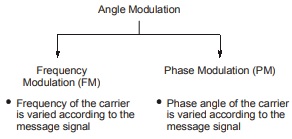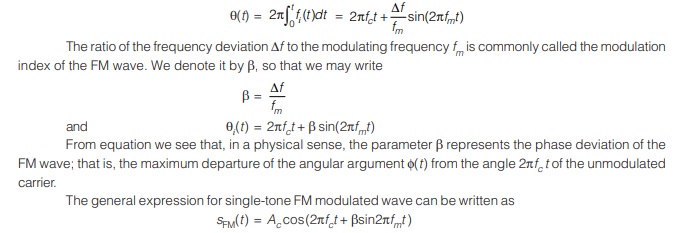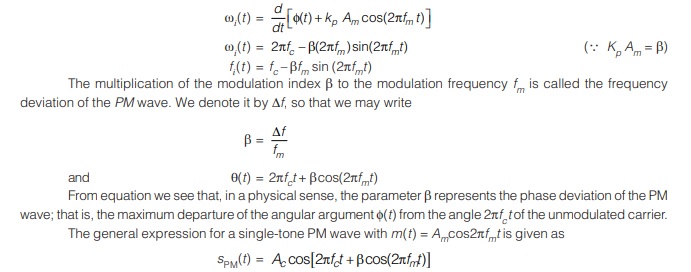Angle Modulation
There is another method of modulating a sinusoidal carrier wave, namely, angle modulation in which either the phase or frequency of the carrier wave is varied according to the message signal. In this method of modulation the amplitude of the carrier wave is maintained constant.
Time Domain Description of Angle Modulation
We begin our study of angle modulation by writing the modulated wave in the general form
x(t) = Acos[θ(t)]
Where the carrier amplitude A, is maintained constant, and the angular argument θ(t) is varied by a message signal m(t). In any event, a complete oscillation occurs whenever θ(t) changes by 2π radians. If θ(t) increases monotonically with time, the average frequency in hertz, over an interval from t to t +∆t, is given by 
Phase Modulation
Phase modulation (PM) is that form of angle modulation in which the angular argument φ(t) is varied linearly with the message signal m(t), as shown by
Here φ(t) ∝ m(t)
therefore, φ(t) = kpm(t)
where, kp is the phase modulation constant with generally the unit of the radian/volts or radian/Ampere.
Now, combining the result with the carrier phase we get,
θ(t)=2πfct + kpm(t)
x(t) = Accos [2πfct + kpm(t)]
Note:
The instantaneous frequency in PM case:
ωi(t) = d0i(t)/dt = ωc + kp dm(t)/dt
fi(t) = ωc /2π + kp /2π d/dt m(t)
Frequency Modulation
Frequency modulation (FM) is that form of angle modulation in which the instantaneous frequency fi(t) is varied linearly with the message signal m(t), as shown by
fi(t) ∝ m(t)
fi(t) = kf m(t)
where, kf is the frequency sensitivity of the modulator with generally the unit of the rad/sec/volt or Hz/volt.
Now, combining the result with the carrier frequency we get,
- If the units of kf is rad/sec-volt, then we write
ωi = ωc + kfm(t)
fi = fc + kf/2π m(t)
- If the units of kf is Hz/volt, then we write
fi = fc + kfm(t)
Single-Tone Frequency Modulation
FM Modulation
Consider a sinusoidal modulating wave defined by
m(t) = Amcos (2πfmt)
The instantaneous frequency of the resulting FM wave equals
fi(t) = fc+ kf Am cos(2πfmt)
= fc + ∆f cos(2πfmt)
where ∆f = kfAm
The quantity ∆f is called the frequency deviation, representing the maximum departure of the instantaneous frequency of the FM wave from the carrier frequency fc . A fundamental characteristic of an FM wave is that the frequency deviation frequency deviation ∆f is proportional to the amplitude of the modulating wave and is independent of the modulation fr modulation frequency.
Using the above equation the regular argument θ(t) of the FM wave is obtained as
PM Modulation
Consider a sinusoidal modulating wave defined by
m(t) = Amcos(2πfmt)
The instantaneous phase of the resulting PM wave equals
![]()
The quantity β is the modulation index, representing the maximum departure of the instantaneous phase of the PM wave from the carrier phase φ(t) = 2πfc t. A fundamental characteristic of an PM wave is that the modulation index modulation index β is proportional to the amplitude of the modulating wave and is independent of the modulation fr modulation frequency.
The instantaneous frequency of the phase modulated wave can be obtained as
<< Previous | Next >>
Must Read: What is Communication?

